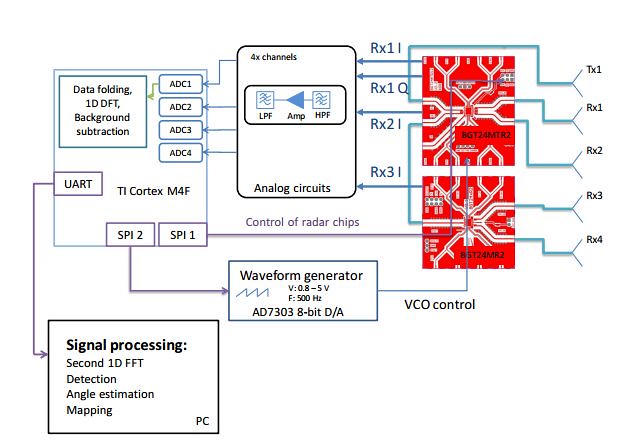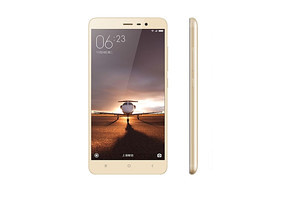Lei feng's network: the writer Gong Liming, via electronics chip engineers.
In 2016, at the Google I/O Conference, Google's low profile showed a number of high-tech hardware products. Including cool radar chip--Project Soli. It uses radar to capture the subtle gestures, implementation for hardware manipulation. It can separate the empty action smart watches, you can manipulate phone replace touch screen separate the empty, you can replace the touch pad computer, even developers achieve telekinesis typing function! It can also interact in VR, replace the handset to get a better gaming experience. Compared to the current two-dimensional touch-screen systems, control gestures it is three dimensional, so even more intuitive, more vivid, coupled with the use of the "electromagnetic waves" that invisible hand to manipulate, some magic effect.
Project Soli constructs:
Project Soli is composed of two chips, one miniature radar sensor chip, a chip is a master. Radar sensor chip has a built-in antenna array package is 8mm x 10MM in size. Radar transmission frequency of the electromagnetic wave is 60GHz, wavelength of 5mm, the chip can identify the subtle gesture 5cm-5M, control distance in 15m, and has a 180 ° angle. The diagram below shows two versions of chip size, the far left is the main control chip, the middle is the radar sensor.

Compared with the original Project Soli. New Project Soli main control chips in cooperation with Infineon designs, 22 times times lower power consumption, reduced from 1.2W to 0.054W. New radar sensor efficiency is increased by 256 times times and scanning of 18,000 frames per second can be achieved. It makes possible for the technology application on the smart watch. Figure below shows several gestures of manipulation:

Radar images:
Google's Project Soli uses radar imaging using 60GHz band millimeter-wave, the wavelength is 5mm. Using millimeter-wave advantage compared with microwave (0.3G~30GHz) the band has almost occupied by a variety of wireless applications, such as WIFI, Bluetooth, wireless, AM, FW wireless broadcasting. Millimeter-wave itself is exempted from licensing, toll-free, and has not been used, in other words, do not take the time required and costs, you can use this band. Wireless HD and IEEE802.15.3c are millimeter-wave wireless transmission technology, working frequency is 60GHz.
Electromagnetic spectrum
Imaging radar uses radio waves reflection. By calculating the antenna emits radio waves, the antenna receives the reflected wave latency, we can draw the object's position. By comparing the emission wavelength of the wave and the reflected wave (Doppler shift), the speed of the object can be calculated. When objects close to the radar moving its shorter wavelength reflection when movement of objects away from the radar, the wavelength of the reflected wave is longer. The speed of the object, the greater, bigger the wavelength changes. Thus, by comparing the launch wave and the reflected wave, got the position and velocity of an object, also fine, to capture the movement of objects.
Radar principles
Using millimeter-wave radar to do gesture recognition, difficulty is the radar sensor chip design, which includes the MMIC chip (monolithic microwave integrated circuit) and antenna PCB Board design.
(1) the front-end MMIC chip: it includes a number of circuits, such as low-noise amplifier (LNA), power amplifiers, mixers, and even system functions. Circuit low loss, low noise, wide bandwidth, wide dynamic range attach, high power, high efficiency, strong resistance to electromagnetic radiation and so on. Millimeter-wave radar key parts of the front end monolithic microwave integrated circuit (MMIC) technology is controlled by foreign semiconductor companies, RF MMIC only at Infineon, Freescale, a very small number of foreign chip makers hand.
(2) high frequency radar antenna PCB Board: millimeter wave microstrip array is the mainstream programmes of the radar antenna, simply integrate the high frequency PCB Board in the General PCB substrate antenna function, need to be integrated in the smaller space keep the antenna signal strength is enough.
NVIDIA gesture recognition chip Hello Kitty Galaxy S5 Cases
Google Project Soli millimeter-wave radar by RDM (Range Doppler Map, range-Doppler mapping) algorithm to obtain information. Google has not announced details of Project design of Soli, but I found that NVIDIA designs a FMCW (frequency modulated continuous wave) gesture recognition technology of millimeter wave radar system, also uses millimeter-wave radar technology, Infineon RF MMIC solutions. Even more is that the RDM algorithm can also be applied in it, should be quite valuable.
Design goals of the system are used for gesture recognition in cars, operating within a distance of 1M. Center frequency 25GHz of millimeter-wave frequency width 4GHz, range resolution is 3.75cm. Has the function of 4D measurement, allowing simultaneous measurement of three dimensional position and velocity, horizontal view angle ± 45 °, vertical angle ± 30 °, speed not higher than 1.5M/s. Design prototypes of the system by the microcontroller, analog circuits, radar antennas, RF chips and 4 road, 3-way antenna, 1-way antenna. Following figure shows the prototype of the system, a little rough, but can be used:
The MMIC front-end system uses the Infineon BGT24MTR2 chip, the host controller uses Texas Instruments Cortex M4F microprocessors. Analog side of the sampling frequency is 40KHz, 8bit a/d conversion, sawtooth wave generator with 500Hz input source to the VCO (voltage controlled oscillator) unit, connected through the serial port PC host and gesture recognition algorithm of signal processing, the system uses USB power supply, power consumption less than 1 w from the machine as a whole. Overall architecture as shown in the following figure:

The whole system works as follows:
1, the signals emitted by the radar system launched the sawtooth function is modulated by the antenna, receiving the hand of ECHO.
2, sawtooth modulation, frequency shifts due to an echo delay and beat (ECHO and launching waves of frequency difference) being coupled together via RDM (Range Doppler Map, range-Doppler map) algorithm for decoupling: multiply the launch wave and echo, and then low-pass filter.
3, results of further discrete sampling, organized into a matrix of the form, where each column of the matrix contains a single scan of the beat signal.
4, followed by two dimensional discrete Fourier transform, and finally the position of the hands of delay and Doppler frequency shift, and other information, and the hand position and velocity.
Below is a diagram of the principle: Hello kitty case for Galaxy s5

Get hand position, and speed charts, you can identify specific gestures and meanings. The diagram below shows the one-handed and two-handed gesture recognition effect: each gesture is at the top of radar image overlay and hand depth. Radar detection of the color of the pace of change in the position of the hand. RDM is in the middle of radar detection, color object that represents the radar detected, due to the Ministry of manpower is very rigid, so it looks like a bunch of small blocks. The below is a composite image showing the entire hand movements, color and speed.
We briefly above the millimeter-wave radar based gesture recognition principle, radar gestures NVIDIA chips in principle Project Soli with Google has a lot of similarities, so have a good reference value.
Difference between the two is that Google is 60GHz band millimeter-wave, and NVIDIA is 25GHz of millimeter-wave; in some different antenna designs and PCB design; Furthermore the NVIDIA the only prototype design, its digital signal processing relies mainly on processing power on the PC side, of course, impossible to integrate into embedded systems.
And Google with a dedicated chip to digital signal processing, so can ultra low power consumption, and improve performance, achieve the requirements of embedded wearable smart devices.
Current Project Soli still in the opening stages. Google says it will launch in 2017 versions of hardware. Is predictable, at the developers Conference next year, we will see more sophisticated radar gesture control chip and supporting software systems, if the costs can be lowered down, perhaps at that time, the new interactive age will come.
This is Lei feng's network (search for "Lei feng's network" public concern) an exclusive special section, please contact the authorized shall not delete, thank you for your cooperation!

1461 votes
Red Note 3
Red Note 3 this new paragraph, rice stressed that this is their first full metal phone, of course it is also owned by millet's first to provide fingerprint identification phone. Red Note 3 gray, silver and gold three optional, millet official stressed that the use of new technology, so that its metal shell fit right in, and in order to guarantee great texture, designed to use the arc-shaped edge, 120th double blast of sand material.
View details of the voting >>

No comments:
Post a Comment